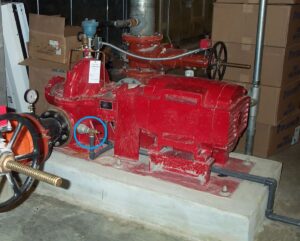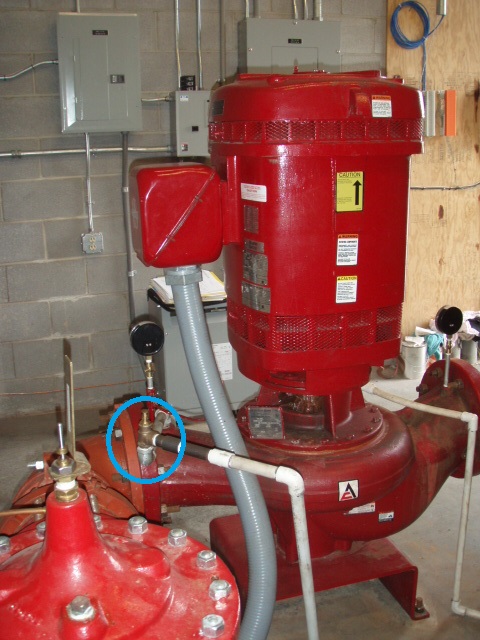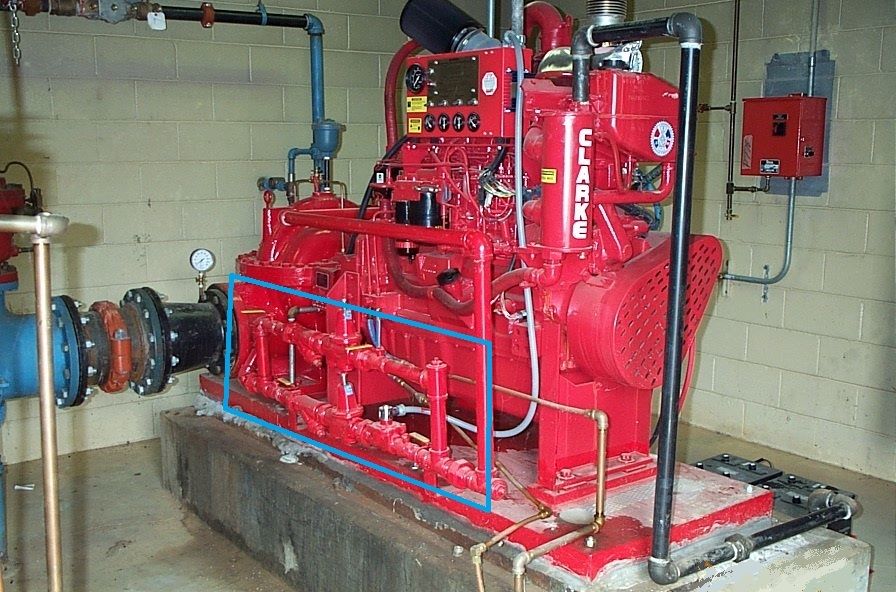In my last blog, we discussed the small PRVs that go on wet sprinkler systems to limit their pressure below 175 psi. That brought to mind a small PRV in another application that is used to keep something different cool: an electric motor-driven centrifugal fire pump. I can’t talk about electric fire pumps without also talking about diesel fire pumps, so let’s dive in and take a look at both!

A circulation relief valve on an electric motor driven centrifugal fire pump. Note that the orientation is horizontal, which, though not ideal, is allowed
Small relief valves are installed on the discharge side of electric motor driven centrifugal fire pumps. These circulation relief valves are intended to allow some water to flow through the pump when it runs at churn, such as during routine testing, to keep the pump casing cool.
A note on the orientation of circulation relief valve, from NFPA 20, 4.12.1.2 enhanced content: “This valve should be installed in the vertical position, because installation in the horizontal position might cause the valve to fail at an accelerated rate due to obstructing material collecting in the valve seat.”
As mentioned in my earlier article, small PRVs are not necessarily known for their great reliability. Over the years, I’ve witnessed countless electric pumps where the circulation relief valve did not open, or didn’t open much, and the pump casing would warm up after just a few minutes of running. Left to run indefinitely this way, it is possible to damage the pump as the water gets hot.
The way to avoid damaging the pump is to ensure, anytime the pump is running, that there is water coming from the drain piping that the circulation relief valve discharges into, AND that the pump casing is remaining cool. The weekly or monthly 10-minute no-flow test is the perfect opportunity to verify these important checks.
How about those diesels? On a heat exchanger cooled, diesel engine driven fire pump, there is no circulation relief valve, because water is pulled off the discharge side of the pump. It serves two purposes: it provides a flow of water to keep the pump cool at churn and it flows through a heat exchanger on the engine to cool the engine.
The cooling water line on a diesel pump will have more gadgets on it than the electric pump’s circulation relief drain line. The primary line has two normally open manual valves, a strainer, a pressure control valve, and a solenoid valve. Then there is a manual bypass line with two normally shut manual valves, a strainer, and a pressure control valve. The manual bypass is there for emergencies; when something has failed with the primary line but there’s a fire and the pump must be kept running. If your pump is old enough, there may not even be a pressure control valve; in those instances, the operator has to control the pressure going to the heat exchanger.
If something happens with the cooling water line, there’s the risk of overheating and damaging the diesel engine and/or the pump, – and in my experience the engine is damaged first. Folks, a friendly reminder: there is no high-temperature shutdown on a diesel fire pump engine. It will run until something breaks.
Let’s look at what can go wrong with the devices on that cooling water line.
First and most commonly, the main strainer gets clogged. This is possible even on clean water sources like city water. Things like sediment, slime, or aquatic debris could be the culprits, but there are too many possibilities to list them all. So, check those strainers and make sure they are clean.
Second, the solenoid could fail. This is an energy-to-open solenoid, so if it fails, the valve stays closed. If this solenoid fails, it is fail-closed. If that happens there is no cooling water being sent to the engine or flowing through the pump. Flow through the cooling water line is something that should be verified visually by the pump operator who attends the pump anytime it starts.
There could be issues on the engine-side even with water flowing through the heat exchanger, so keep an eye on the engine temperature while it is running.
So now you know more about keeping fire pumps cool, not just in the summer but all the time. Here are the bottom lines: make sure visually that there is some water flowing from the discharge side of the pump into a drain somewhere, make sure the pump casing remains cool while it’s running, and mind the temperature of a diesel engine.
The bottom-bottom line: in the event of a fire in the protected area, a fire pump runs no matter what, even if running leads to engine or pump failure.
Amy Anderson, PE, CFEI, has a Bachelor of Science in Chemical Engineering from Clemson University and is a licensed Professional Engineer in Fire Protection, as well as a Certified Fire and Explosion Investigator. Amy has over 20 years of engineering experience including property loss prevention engineering specializing in fire protection, chemical and pharmaceutical facilities. She has partnered with clients to identify, assess, avoid, and reduce risk at their commercial and industrial properties. Additionally, she has assisted with the development of building and fire protection specifications, reviewed plans and performed site visits. She has reviewed project documents for compliance with applicable standards – construction, fire protection, process, and combustible dust hazards. Amy is a member of the National Association of Fire Investigators, the Society of Fire Protection Engineers, the National Fire Protection Association and the American Institute of Chemical Engineers.





